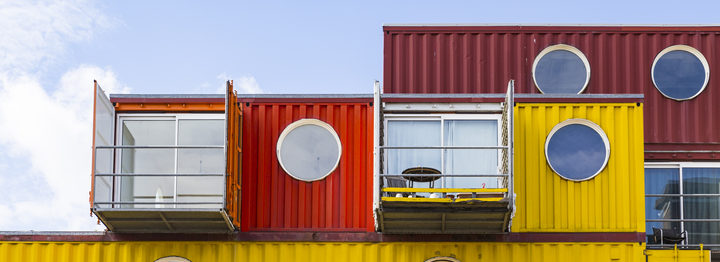
Over the past few years, we’ve seen a few innovative housing trends emerge to fill the void that exists in overpriced housing markets where it’s nearly impossible for middle-class families to find affordable housing. And while you’re probably familiar with the tiny house movement, you may not be as aware of another popular trend that’s sweeping the nation: container homes.
Shipping containers have long been used to move goods from one location to another. They’re often loaded onto massive shipping boats, trains, or even tractor-trailers and provide an easy way to group shipments together and maximize space. But have you ever wondered what happens to these shipping containers after they arrive at their destination and the contents are unloaded?
After companies ship products in shipping containers, it’s usually more expensive for them to ship back the containers than to simply discard and buy new ones. As a result, many containers are left unused. Some are melted down – which causes a significant source of pollution – while others are vacant and take up space.
Over the years, savvy individuals have found a variety of applications for repurposing these shipping containers. Recently, architects and designers have started to use them as unique forms of affordable housing.
If you’re interested in learning more about the shipping container housing trend and what it looks like in practical terms, you’re in the right place. Here’s everything you need to know:
The first thing to think about is the size of shipping container you want. There are two standard sizes in the industry: 20x8x8-foot containers with 160 square feet and 40x8x8-foot containers with 320 square feet. Furthermore, you can combine multiple containers to create a larger home. Some of the larger container homes are comprised of 10 or more containers stacked and aligned in unique configurations.
It all depends on where you’re located and how much inventory there is, but expect to pay between $1,500 and $3,000 for a 20-foot container and $3,500 to $4,500 for a 40-foot container.
You can also buy pre-fabricated container houses, though these will be much more expensive and will limit your ability to customize.
Just because you want to build a container house doesn’t mean you can – at least in the location you initially want. Container houses must fit the standard rules, regulations, and zoning requirements in your area. It’s highly unlikely that you’ll be able to build in a residential neighborhood with an HOA. You’ll almost certainly have to buy some land in a rural area, or find an area of the county where the building restrictions are lax.
You also have to account for container-specific rules. As designer Mads Moller mentions, “Every country has its own sets of rules and standards. This means a container house in US does not look like a container house in Denmark. That is something most people do not think about. The container is a generic product, but climate, fire regulations etc. are not.”
If possible, you should see the actual containers before you purchase. While most container sellers promise good condition, many people are disappointed when they show up battered and bruised.
You also need to inquire about how the shipping containers were used in their previous life. Containers weren’t originally built for residential use and may have hazardous materials that are dangerous to your health – including phosphorus, chromate, lead-based paint, arsenic, or chromium. However, all of these issues can be avoided with some proper research.
It’s one thing to read about container homes online and do a little poking around internet message boards and YouTube video comment sections, but you should make it a point to sit down and have conversations with other people who have built and lived in container homes. There’s no substitute for the real thing, and these folks can provide you with invaluable information.
Some of the things you’ll likely learn:
As you talk with people, pick their brains. No question should be considered too basic. Information is worth its weight in gold.
Many homeowners choose to tackle much of the build themselves, but you’ll likely need some help with the major aspects – including foundation work, electrical, plumbing, and modular configuration. Instead of hiring one contractor for each job, try to find a contractor who can handle and oversee the project from start to finish.
Ideally, your contractor should have some experience with a container build in the past. This will help with all of those small problems that most people encounter when they perform one of these projects for the first time.
While it may sound rudimentary, the reality is that shipping container homes can be quite luxurious. If you’re intrigued by the idea, maybe you should take a chance and dive in headfirst.
At Green Residential, we can help you with the sale of your existing home – and we’ll let you keep more of your hard-earned equity. Because we operate on a flat fee – rather than a traditional commission structure – you can save thousands. Contact us today to learn more!
